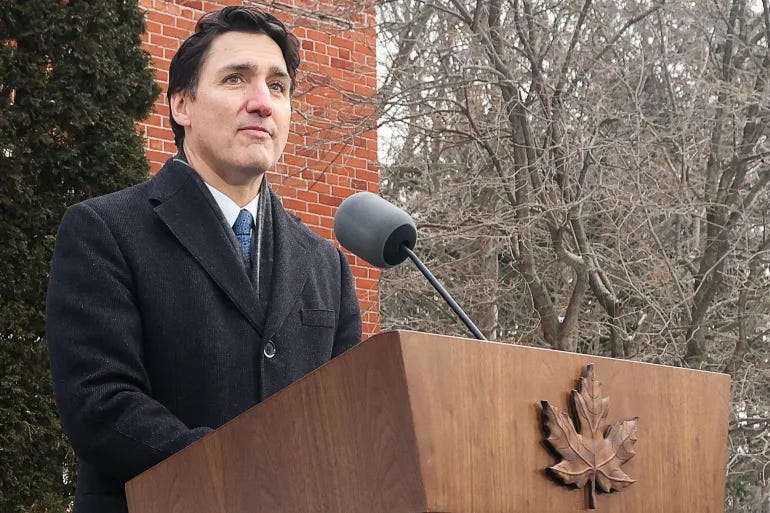Why Justin Trudeau Resigned and What’s Next for Canada
Amid political tension, rising dissent, and falling polls, the Canadian Prime Minister steps down—ushering in a new era of leadership challenges.
Canadian Prime Minister Justin Trudeau has announced his decision to resign as leader of the Liberal Party, following months of internal turmoil and declining popularity. The resignation, revealed on Monday, marks the end of his leadership amid ongoing conflicts with political allies, looming challenges in the upcoming federal elections, and falling public support.
In his emotional farewell statement from Rideau Cottage in Ottawa, Trudeau reflected on his time in office, saying, "Every morning I’ve woken up as prime minister, I’ve been inspired by the resilience, generosity, and determination of Canadians." However, acknowledging the growing internal struggles within his party, he stated that he would step aside once a replacement is chosen, emphasizing the need for "a real choice" in the upcoming election.
Trudeau’s Legacy and Achievements
Trudeau, 53, entered politics in 2008, representing a working-class neighborhood in Montreal. The eldest son of iconic former Prime Minister Pierre Trudeau, Justin quickly rose to national prominence. He became Prime Minister in 2015, leading the Liberals to victories in 2019 and 2021.
Throughout his tenure, Trudeau championed progressive policies, such as legalizing cannabis, introducing a carbon tax, and negotiating a new trade agreement with the United States. He also launched initiatives to address the issue of missing and murdered Indigenous women and expanded financial support for Canadian families.
Despite these accomplishments, Trudeau’s popularity has sharply declined in recent months, driven by a combination of political missteps and external pressures, including challenges from the incoming U.S. administration under President Donald Trump.
The Events Leading to Trudeau’s Resignation
Trudeau’s political fortunes took a turn after several high-profile public disputes and the looming threat of a no-confidence motion. His handling of trade tensions with the United States, particularly with Trump’s tariff threats, deepened divisions within his cabinet. In December, Deputy Prime Minister Chrystia Freeland resigned after publicly criticizing Trudeau’s approach to handling the trade dispute. Freeland’s departure, along with increasing calls for Trudeau’s resignation from within the Liberal Party, led to the eventual decision to step down.
In his resignation announcement, Trudeau expressed that the party’s internal battles made it clear that he was no longer the best candidate to lead the Liberals into the next federal election. His departure has been met with mixed reactions, but many, including Freeland, have publicly supported his decision.
What Happens Next for Canada?
Trudeau’s resignation sets the stage for a leadership race within the Liberal Party, which must select a new leader before the next federal election, expected before October 20. The race to succeed Trudeau is already heating up, with several prominent Liberal politicians tipped as potential candidates, including former Bank of Canada Governor Mark Carney, Minister of Innovation François-Philippe Champagne, and former Deputy Prime Minister Chrystia Freeland.
However, the timing of Trudeau’s departure presents a challenge. Leadership conventions typically take months to organize, and if an election is called before a new leader is chosen, the Liberals could face a difficult situation, with the party being led by a prime minister not selected by the membership.
The Political Landscape: Enter Pierre Poilievre
As Trudeau steps down, Conservative Party leader Pierre Poilievre is emerging as the frontrunner to become Canada’s next prime minister. Recent polls show Poilievre with a commanding lead over Trudeau’s Liberals, with some predicting a significant shift in power if an election were held today.
Poilievre, known for his direct and often combative political style, has drawn comparisons to U.S. President Donald Trump. His messaging has resonated with a large base of Canadians, and he has repeatedly emphasized the slogan “Canada first,” drawing parallels to Trump’s “America first” rhetoric.
With tensions running high in Canadian politics, Poilievre is expected to continue challenging Trudeau’s legacy, while advocating for a shift away from Trudeau’s policies in favor of his own vision for the country.
What Lies Ahead for Canada?
Trudeau’s resignation marks the end of an era for Canadian politics. As the country braces for an impending federal election, the future direction of the Liberal Party, and Canada as a whole, remains uncertain. The leadership race to succeed Trudeau will undoubtedly shape the political landscape in the years to come, with the Conservatives, led by Poilievre, eager to capitalize on the opportunity to reclaim power.
Regardless of the outcome, Canada’s political future is now in the hands of a new generation of leaders, tasked with navigating the challenges of trade, climate change, and the evolving relationship with the United States. The next steps will be pivotal for the country’s trajectory as it moves forward from Trudeau’s leadership.


